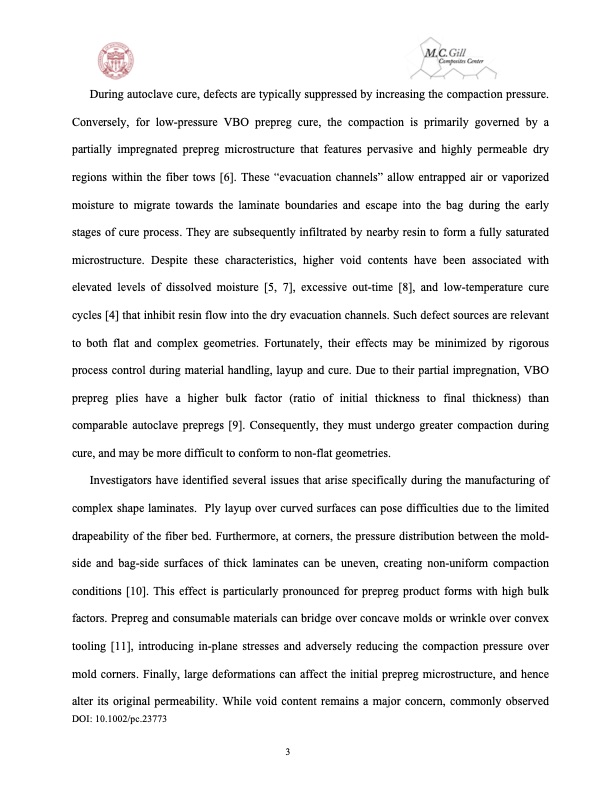
PDF Publication Title:
Text from PDF Page: 003
During autoclave cure, defects are typically suppressed by increasing the compaction pressure. Conversely, for low-pressure VBO prepreg cure, the compaction is primarily governed by a partially impregnated prepreg microstructure that features pervasive and highly permeable dry regions within the fiber tows [6]. These “evacuation channels” allow entrapped air or vaporized moisture to migrate towards the laminate boundaries and escape into the bag during the early stages of cure process. They are subsequently infiltrated by nearby resin to form a fully saturated microstructure. Despite these characteristics, higher void contents have been associated with elevated levels of dissolved moisture [5, 7], excessive out-time [8], and low-temperature cure cycles [4] that inhibit resin flow into the dry evacuation channels. Such defect sources are relevant to both flat and complex geometries. Fortunately, their effects may be minimized by rigorous process control during material handling, layup and cure. Due to their partial impregnation, VBO prepreg plies have a higher bulk factor (ratio of initial thickness to final thickness) than comparable autoclave prepregs [9]. Consequently, they must undergo greater compaction during cure, and may be more difficult to conform to non-flat geometries. Investigators have identified several issues that arise specifically during the manufacturing of complex shape laminates. Ply layup over curved surfaces can pose difficulties due to the limited drapeability of the fiber bed. Furthermore, at corners, the pressure distribution between the mold- side and bag-side surfaces of thick laminates can be uneven, creating non-uniform compaction conditions [10]. This effect is particularly pronounced for prepreg product forms with high bulk factors. Prepreg and consumable materials can bridge over concave molds or wrinkle over convex tooling [11], introducing in-plane stresses and adversely reducing the compaction pressure over mold corners. Finally, large deformations can affect the initial prepreg microstructure, and hence alter its original permeability. While void content remains a major concern, commonly observed DOI: 10.1002/pc.23773 3PDF Image | Vacuum Bag-Only Prepregs

PDF Search Title:
Vacuum Bag-Only PrepregsOriginal File Name Searched:
J224.pdfDIY PDF Search: Google It | Yahoo | Bing
5,000 BF Shipping Container Lumber Dry Kiln For Quality Lumber The 5,000 BF container kiln consists of one 40 foot high-cube aluminum shipping container... More Info
Shipping Container Lumber Dry Kilns by Global Energy Global Energy designed and developed the container kiln back in 1991. The purpose is to give access to portable sawmill owners, furniture makers, and small business the value added profit of dry kiln lumber and quality hardwoods... More Info
Vacuum Kiln Conversion Kit for Lumber and Wood Dry Kilns Convert your existing conventional dry kiln into a fast drying vacuum kiln. Similar to vacuum bagging in the boat building and aircraft industry, we have come up with a proprietary process which allows you to build a very simple vacuum kiln at a fraction of the price, and without the intensive conventional metal chamber structure... More Info
Vacuum Pump Cart System for Bagging Clamping Wood Drying and more Vacuum Cart with 2HP Pump and Dual Pistons with multiple multiplex vacuum ports and liquid reservoir... More Info
Vacuum Bagging Basics Vacuum bagging is a method of clamping, which has traditionally been used in the composites industry, but can also be used for vacuum drying materials, including wood products... More Info
| CONTACT TEL: 608-238-6001 Email: greg@globalmicroturbine.com | RSS | AMP |